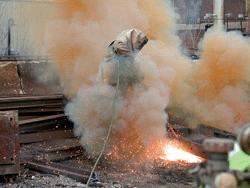Evaluation of sequential extraction procedures for soluble and insoluble hexavalent chromium compounds in workplace air samples†‡
Abstract
Because toxicities may differ for

* Corresponding authors
a
U.S. Department of Health and Human Services, Centers for Disease Control and Prevention, National Institute for Occupational Safety and Health, 4676 Columbia Parkway, Mail Stop R-7, Cincinnati, OH, USA
E-mail:
KAshley@cdc.gov
Tel: +1(513)841-4402
b U.S. Department of Health and Human Services, Centers for Disease Control and Prevention, National Institute for Occupational Safety and Health, 315 E. Montgomery Avenue, Spokane, WA, USA
c North Idaho College, 1000 W. Garden Avenue, Coeur d'Alene, ID, USA
d Institut National de Recherche et de Sécurité, Département Métrologie des Polluants, Rue du Morvan, CS 60027, 54519 Vandœuvre-les-Nancy, France
Because toxicities may differ for

 Please wait while we load your content...
Something went wrong. Try again?
Please wait while we load your content...
Something went wrong. Try again?
K. Ashley, G. T. Applegate, A. D. Marcy, P. L. Drake, P. A. Pierce, N. Carabin and M. Demange, J. Environ. Monit., 2009, 11, 318 DOI: 10.1039/B812236A
To request permission to reproduce material from this article, please go to the Copyright Clearance Center request page.
If you are an author contributing to an RSC publication, you do not need to request permission provided correct acknowledgement is given.
If you are the author of this article, you do not need to request permission to reproduce figures and diagrams provided correct acknowledgement is given. If you want to reproduce the whole article in a third-party publication (excluding your thesis/dissertation for which permission is not required) please go to the Copyright Clearance Center request page.
Read more about how to correctly acknowledge RSC content.
 Fetching data from CrossRef.
Fetching data from CrossRef.
This may take some time to load.
Loading related content
